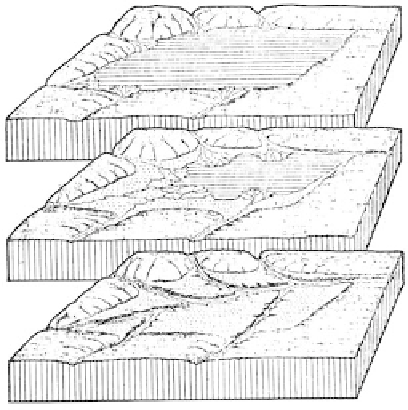Environmental Engineering Reference
In-Depth Information
(a)
(b)
(c)
FIGURE 7.58
Life cycle of a typical lake: (a) stream system formed by gentle upwarp forming a shallow lake; (b) the streams
entering the lake build deltas which enlarge and coalesce as the lake body is filled with fines; (c) the outfall
channel slowly degrades its outlet, lowering the lake level until eventually only the lake bottom remains.
Entrenching by the stream leaves terraces. (From Long well, C. R. et al.,
Physical Geology
, 3rd ed., Wiley, New
York, 1948. Reprinted with permission of John Wiley & Sons Inc.)
precipitated. The salt type reflects the rock type in the drainage area, as well as other factors,
and can vary from sodium chloride (common salt) to sodium sulfate, sodium and potassium
carbonates (alkali lakes), and borax (Hunt, 1972). The salts impart a light cementation to the
soil particles, which dissolves upon saturation, resulting in ground collapse and subsidence.
Ancient Lakes in Dry Climates
The remains of once-enormous Pleistocene lakes, shrunken by evaporation, are evident as
salt flats extending over many hundreds of square miles of the Bolivian plateau, western
Utah, and western Nevada as well as other arid regions of the world.
The Great Salt Lake is all that remains of Lake Bonneville, which once covered 20,000 mi
2
(50,000 km
2
) and was 1000 ft (300 m) deep. Sediments from melting glaciers filled in the
depression formed by crustal warping and faulting. Many depositional forms are evident
in the former lake basin, including deltas and wave-cut terraces along former shore lines at
several different elevations, gravel and sand bars, spits, and fine-grained lake bottom sed-
iments. These latter materials, soft clays and salt strata, were the cause of numerous failures
and the subsequent high costs during the construction of the 20-mi-long embankment for
the Southern Pacific Railroad, which was only 12 ft in height (A. Casagrande, 1959). Hunt
(1972) notes that shorelines along islands in the central part of the basin are about 160 ft
higher than along the eastern and western shores, which he attributes to crustal warping
during rebound from unloading by evaporation of hundreds of feet of water.
Swamps and Marshes
Occurrence
Swamps and marshes develop in humid regions over permanently saturated ground.
A swamp has shrub or tree vegetation and a marsh has grassy vegetation. They are
commonly associated with lakes and poorly drained terrain in any location, and with


